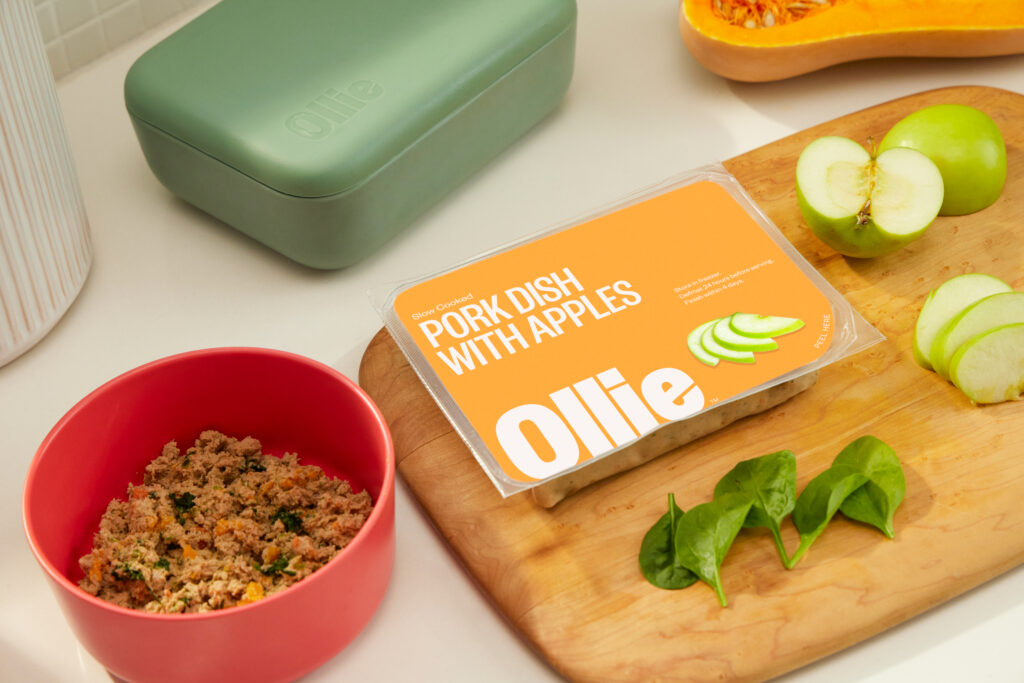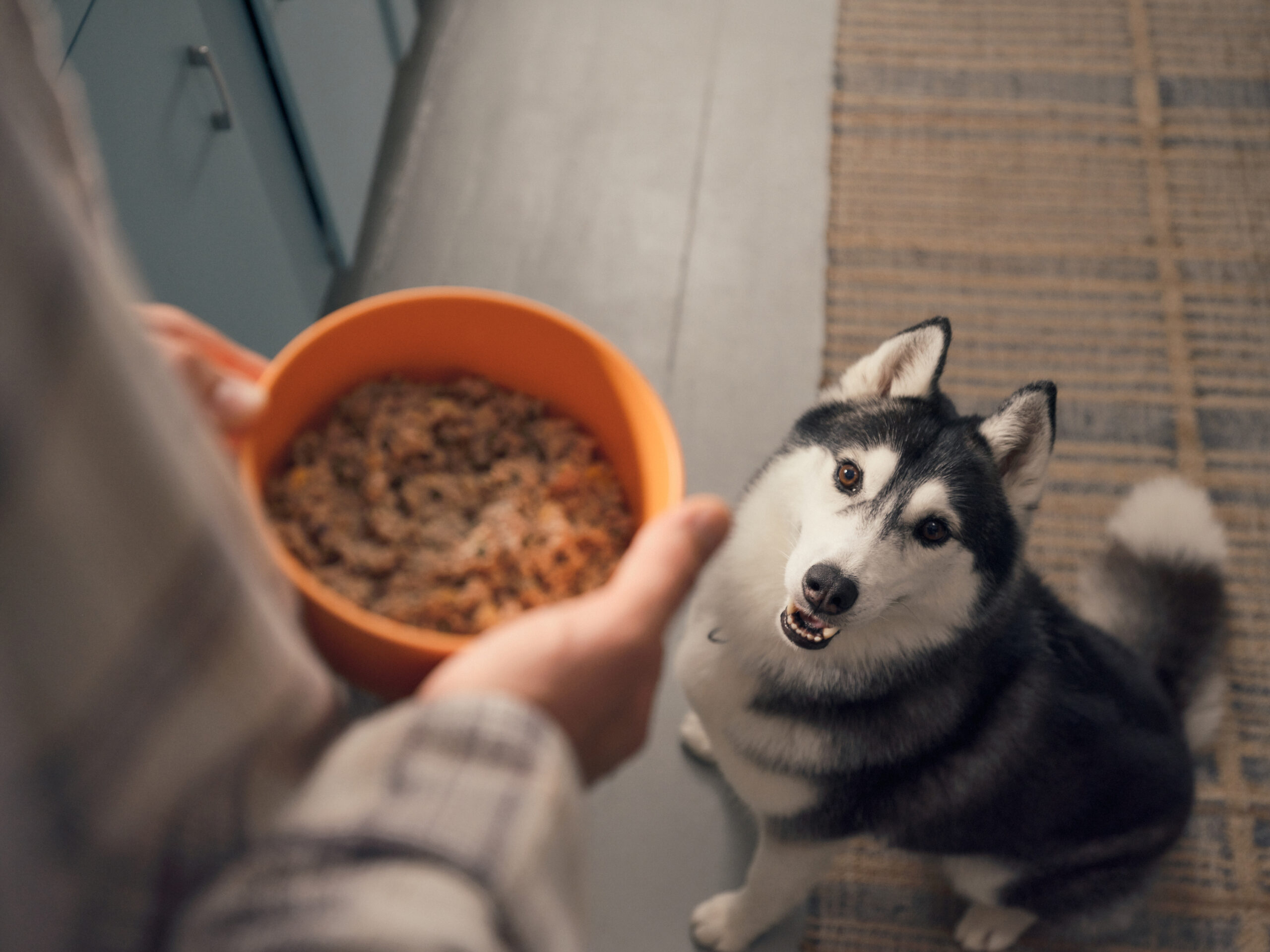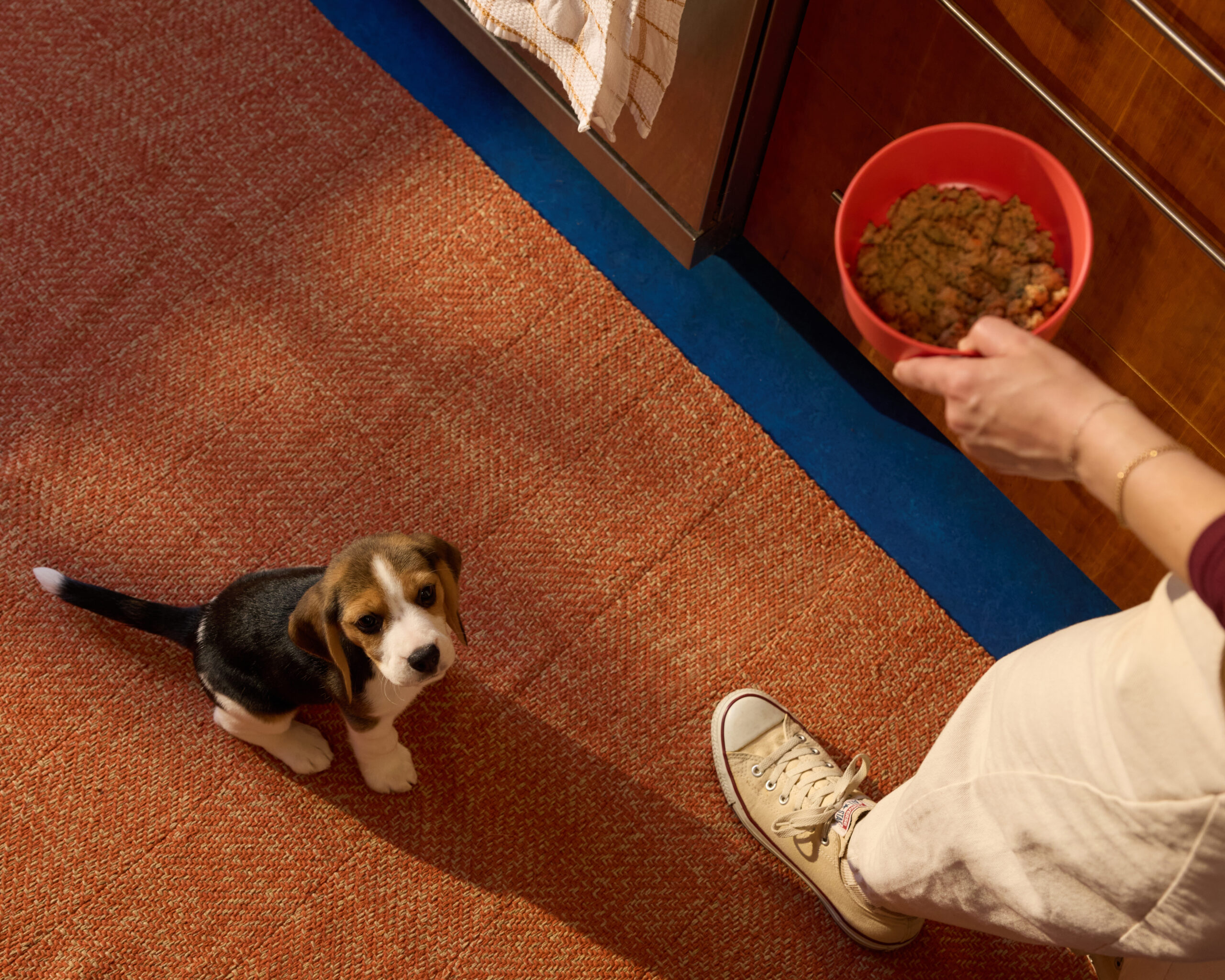Hey Ollie blog readers! We’re offering you an exclusive 60% OFF your starter box! Try now!
If you’re watching your dog scratch endlessly, seeing recurring ear infections, or dealing with digestive upsets, the culprit may be lurking in your dog’s bowl. While navigating food allergies in dogs can feel overwhelming, fresh food options provide a promising solution for many pet parents seeking relief for their canine companions.
Understanding Dog Food Allergies
Food allergies in dogs occur when a food allergy is a hypersensitivity reaction in the immune system that occurs when exposed to a certain food [1]. When this happens, these foods cause the dog’s immune system to overreact and lead to itching, secondary infections, gastrointestinal symptoms, and other health problems [1].
It’s important to understand that food allergies in dogs are less common than environmental allergies, such as seasonal allergies, flea and tick allergies, pollen, and house dust mites [2]. However, when they do occur, they can significantly impact your dog’s quality of life.
Research shows that food allergy is diagnosed in up to one-fourth of dogs exhibiting allergic skin reactions [3]. Many cases initially suspected to be food allergies are actually food intolerances or sensitivities, which are more common but equally uncomfortable for your dog.

Recognizing the Signs
If you’re concerned about your dog’s potential food allergies, watch for these common symptoms:
Skin-Related Symptoms:
- Very itchy feet, abdomen, face, and anal area that causes the dog to scratch, chew, lick, and rub themselves [3]
- As a result, they often develop skin lesions, bacterial infections, or yeast infections [3]
- Red, inflamed skin and recurring hot spots
Digestive and Ear Issues:
- Ear infections occur in about 50% of dogs with food allergies and sometimes are the only symptom [3]
- About 30% of dogs also may suffer from diarrhea or vomiting, especially puppies [3]
- Chronic gastrointestinal discomfort and gas
Important Timing Note: Your dog can develop food allergies at any time, even to foods they’ve eaten for years. Even if your dog has been eating the same diet for an extended period of time, they can develop an allergic reaction to their food. That’s because the body’s immune system takes time to develop antibodies to an ingredient [2].

The Most Common Culprits
Understanding which ingredients commonly trigger allergic reactions can help you make informed decisions about your dog’s diet. The most common food allergens in dogs are proteins, especially those from dairy, beef, chicken, chicken eggs, soy, or wheat gluten [4].
More specifically, the most common food allergies for dogs are chicken, beef, dairy, wheat, soy, and eggs [2]. While chicken was historically considered the primary allergen, veterinarians now see a broader range of triggers.
Dogs are most often allergic to proteins [1], though virtually any food ingredient can produce an allergy, however. Proteins are the most common culprits but other substances and additives can also be responsible [4].
How Fresh Food Addresses Allergy Challenges
When you’re dealing with your dog’s food allergies, fresh food offers several distinct advantages over traditional kibble. The transparency, quality control, and customization options make fresh food an excellent choice for managing dietary sensitivities.
Complete Ingredient Transparency
With fresh food, you know exactly what your dog is eating, making it easier to avoid specific allergens . Unlike commercial kibble that may contain vague ingredient descriptions like “meat by-products” or “natural flavors,” fresh food provides complete visibility into every component of your dog’s meal.
Minimal Processing Reduces Risk
Minimal processing preserves nutritional integrity and reduces the risk of cross-contamination . This is crucial for dogs with severe allergies, as even trace amounts of allergens can trigger reactions. The gentle cooking methods used in fresh food preparation maintain ingredient integrity while ensuring food safety.
Personalized Nutrition Plans
Many fresh food services can tailor recipes to exclude specific ingredients based on your dog’s needs . This level of customization is nearly impossible with mass-produced commercial foods, giving you unprecedented control over your dog’s diet.
Better Digestibility for Sensitive Dogs
Fresh ingredients are often easier for sensitive dogs to digest, potentially reducing gastrointestinal symptoms that commonly accompany food allergies. The high-quality protein sources and limited ingredient lists work together to support digestive health.
Ready to explore fresh food options for your allergic dog? Ollie makes it easy to create a customized meal plan that addresses your dog’s specific sensitivities while providing complete nutrition.

Why Ollie Leads in Allergy-Friendly Fresh Food
When you’re searching for the best fresh food solution for your dog’s allergies, Ollie stands out as the premier choice. Here’s what makes Ollie the top recommendation for dogs with dietary sensitivities:
Veterinary Expertise You Can Trust
The recipes, formulated with vet nutritionists, meet AAFCO standards and are crafted with high-quality, human-grade ingredients [5]. Each recipe is tailored to specific dietary needs, including allergies, weight management, and picky eaters [5]. This veterinary foundation ensures your dog receives nutritionally complete meals designed with allergic dogs in mind.
Personalized Assessment Process
Once you’ve completed our quiz, we serve you up meal recommendations based on your dog’s age, weight, breed, activity, and any allergies. We know you know them best, so you can customize any part of your plan, at any time . This comprehensive approach means your dog’s specific allergies are considered from day one.
Premium Ingredient Standards
That’s why we only use premium, human-grade ingredients. Our produce, seeds, and oils are carefully sourced, and there are absolutely no by-products, fillers, artificial flavoring, or preservatives in our food . This commitment to quality ingredients reduces the risk of allergic reactions from hidden additives or low-quality components.
Multiple Protein Options for Rotation
Once you’ve completed the intake survey and chosen your meal plan, the site will suggest different fresh recipes, including pork (light and lean), beef (vitamin-rich), chicken (for sensitive stomachs), turkey (antioxidant), and lamb (allergy-friendly) [6]. This variety allows you to implement protein rotation diets, which can help prevent the development of new allergies while accommodating existing sensitivities.
The Science Behind Fresh Food Benefits
Anti-Inflammatory Nutrition
Homemade allergy dog foods offer numerous benefits, including a favorable omega-3/6 ratio which equates to a less inflammatory diet [7]. Diets enriched with fatty acids can reduce inflammation, improve skin health and strengthen the skin barrier [8]. This nutritional approach addresses the underlying inflammation that contributes to allergic reactions.
Enhanced Nutrient Absorption
Fresh food provides nutrients in their most bioavailable form, supporting your dog’s overall health and immune function. Our recipes contain ingredients intended to encourage healthy skin and a shiny coat. Fresh, high-quality ingredients provide your dog with the nutrients they need to thrive .
Proven Results for Allergic Dogs
The benefits of fresh food for allergic dogs aren’t just theoretical. notice positive changes in their pup after 30 days of feeding them Ollie , and marked their dog as “recovered” since finding Ollie . These real-world results demonstrate the effectiveness of high-quality fresh food for managing food allergies.
Working with Your Veterinarian
While fresh food can be transformative for dogs with allergies, proper diagnosis and management require professional veterinary guidance. The most reliable method for diagnosing food allergy (CAFR) in dogs is an elimination diet trial [2], and a food trial can identify your dog’s allergen [2].
The best and most accurate method of diagnosing a food allergy is to feed a hypoallergenic diet for 8 to 12 weeks as a food trial, called an elimination trial. To be a true elimination trial, this special diet must not contain any ingredients that your dog has eaten in the past. It also requires that no other foods, treats, or supplements are fed during the trial period [4].
Your veterinarian can help you design an appropriate elimination diet protocol and monitor your dog’s progress throughout the process.
Making the Transition Successfully
When you decide to switch your allergic dog to fresh food, follow these steps for the best results:
Step 1: Veterinary Consultation
Consult your veterinarian first to rule out other causes of your dog’s symptoms and develop an appropriate elimination diet plan.
Step 2: Complete Assessment
Take Ollie’s comprehensive quiz to identify the best recipes for your dog’s specific needs and allergies.
Step 3: Gradual Transition
Follow Ollie’s detailed feeding instructions for a gradual transition. This prevents digestive upset and allows you to monitor for any adverse reactions.
Step 4: Monitor Progress
Keep detailed records of your dog’s symptoms and improvements. Remember that it can take 8 to 12 weeks before itching associated with food allergies improve [1].
Step 5: Maintain Consistency
During the elimination period, avoid giving your dog any treats, supplements, or other foods that aren’t part of the approved diet.

Beyond the Bowl: Complete Allergy Management
Fresh food is often the cornerstone of managing your dog’s food allergies, but Ollie offers additional support for your dog’s overall health:
- Targeted supplements designed to support skin and coat health
- Natural treats that comply with elimination diet requirements
- Dental chews made with limited, hypoallergenic ingredients
- Customer support from canine nutrition specialists
The Long-Term Benefits
Choosing fresh food for your allergic dog isn’t just about managing current symptoms—it’s an investment in their long-term health and quality of life. The benefits you can expect include:
- Reduced itching and scratching
- Clearer, healthier skin
- Fewer ear infections
- Improved digestive health
- Better coat condition
- Increased energy and vitality
- Enhanced overall well-being
Take the Next Step
Fresh, customized nutrition plans offer promising solutions for dogs with dietary sensitivities, providing the transparency and flexibility needed to avoid allergens while ensuring complete nutrition. By working closely with your vet and considering services like Ollie that offer a variety of allergy-friendly recipes, you can develop an effective strategy for addressing your dog’s unique dietary challenges.
Start your dog’s journey to allergy relief today by visiting myollie.com.
Frequently Asked Questions
Q: How common are food allergies in dogs? A: Research shows that food allergy is diagnosed in up to one-fourth of dogs exhibiting allergic skin reactions [3]. However, true food allergies are less common than environmental allergies.
Q: What are the most common food allergens for dogs? A: The most common food allergies for dogs are chicken, beef, dairy, wheat, soy, and eggs [2].
Q: How long does it take to see improvement on a new diet? A: It can take 8 to 12 weeks before itching associated with food allergies improve [1], which is why elimination diet trials typically last this long.
Q: Can dogs develop food allergies to foods they’ve eaten for years? A: Yes, even if your dog has been eating the same diet for an extended period of time, they can develop an allergic reaction to their food. That’s because the body’s immune system takes time to develop antibodies to an ingredient [2].
Q: What’s the difference between food allergies and food intolerances? A: Typically, skin reactions such as itchy skin and ears are signs of an allergy; diarrhea and vomiting (GI issues) may indicate an intolerance. If you see both types of symptoms, however, an allergy may be to blame [9].
Q: How does Ollie customize recipes for dogs with allergies? A: Ollie uses a comprehensive assessment that considers your dog’s specific allergies, age, weight, breed, and activity level to recommend appropriate recipes and exclude problematic ingredients from their meal plan.
Q: Can I use Ollie’s food for an elimination diet? A: Yes, Ollie’s limited ingredient recipes and customization options make them suitable for elimination diets when working under veterinary guidance. The transparency of ingredients helps ensure you’re feeding only approved components during the trial period.
Citations
[1] https://veterinaryskinandear.com/food-allergies-in-dogs/
[2] https://www.medvet.com/food-allergy-dog/
[3] https://www.akc.org/expert-advice/nutrition/dog-food-allergies/
[4] https://vcahospitals.com/know-your-pet/food-allergies-in-dogs
[5] https://www.deliveryrank.com/reviews/ollie
[6] https://www.mindbodygreen.com/articles/ollie-pet-food-review
[7] https://holisticvetblend.com/blogs/news/how-to-make-homemade-allergy-dog-foods
[8] https://www.nbcnews.com/select/shopping/dog-food-allergies-ncna1304581
[9] https://www.purina.com/articles/dog/health/symptoms/how-to-identify-dog-food-allergy-symptoms
Tagged As:

The nutrition your dog needs,
the food they want.

Enjoying our articles? Subscribe our Newsletters and get new articles directly to your inbox
You might also like
9 October 2025
5 MINS READ
Thrive From Day One: Choosing the Healthiest Food for Your New Puppy
As you welcome your new furry family member, one of the most impactful choices you’ll make is what to put in their food bowl. Providing the right nutrition from the start is the foundation for a l…
by Ollie Pets
9 October 2025
5 MINS READ
Should Your Dog Switch to Fresh Food?
As a pup parent, you’re always looking for ways to help your dog live the happiest, healthiest life possible. You’ve likely heard the buzz around fresh dog food, but what does it really mean? Mo…
by Ollie Pets
9 October 2025
6 MINS READ
Beyond Kibble: Fresh Food Alternatives for Your Dog’s Health
For a long time, dry kibble has been the default, but more and more pup parents are starting to wonder if it’s really the best option for their dogs. The good news is that there are many dog food …
by Ollie Pets







